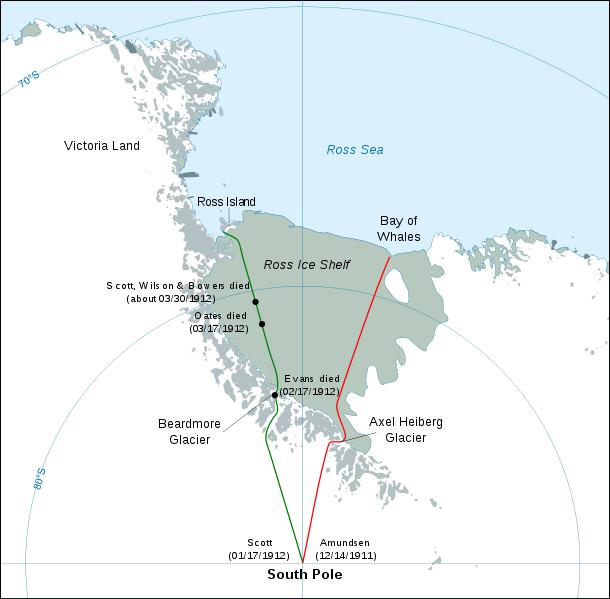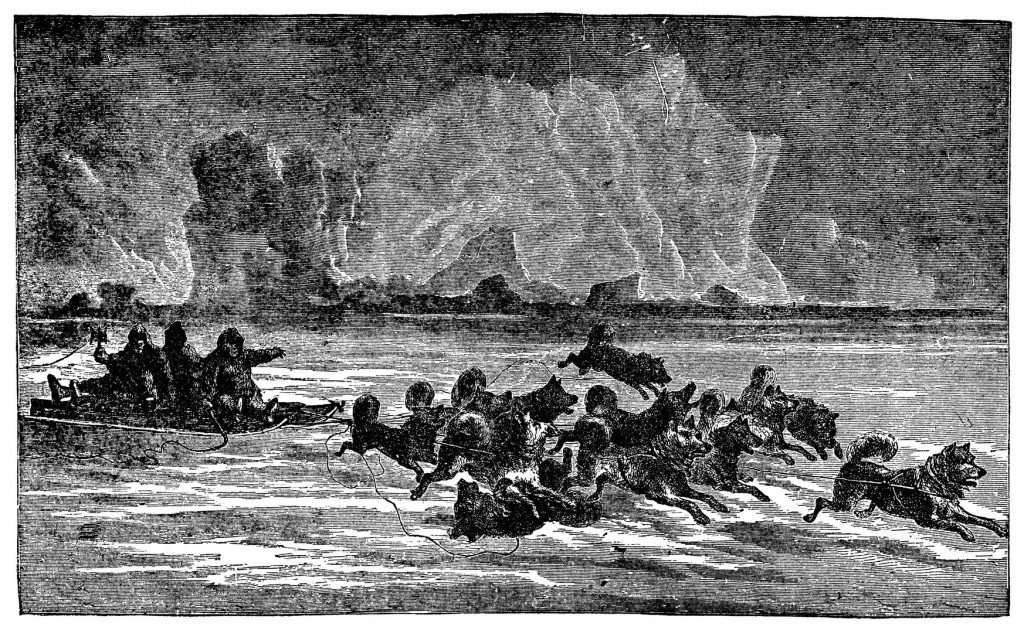David Schleich, PhD
Keeping the Philosophy on the Sled
This is the second of two parts. Part 1 was published in the July 2011 edition of NDNR.
Using skis and dogsleds for transportation, Amundsen and his men made meticulous preparations, just as Scott did, with neither team relying on intuition alone. They set up depots at 80°, 81°, and 82°S on the Barrier, along a trajectory directly south of the pole. Unlike Scott, whose canned goods and snow machines were state of the art at the time, Amundsen’s provisions included pemmican, dogs not only to pull the supply sleds but also as a potential source of fresh meat, and animal skin clothing to protect against the dangerous cold. Amundsen’s team had one false start on September 8, 1911, which included fellow explorers Hjalmar Johansen, Kristian Prestrud, and Jørgen Stubberud. Amundsen recognized the limits of their capacity and the realities of the terrain and abandoned the run because of extreme temperatures.
A patient month later, though, watching the mood and texture of the land before them, Olav Bjaaland, Helmer Hanssen, Sverre Hassel, Oscar Wisting, and Amundsen himself set out once again on October 19, 1911, with four sledges and 52 dogs. They had studied the natural terrain and chose a route along the previously unknown Axel Heiberg Glacier. They walked and climbed steadily, taking their lead from the weather, the dogs, and their intuition, arriving at the edge of the Polar Plateau on November 21, after a four-day climb. Finally, on December 14, 1911, the team of six, with 16 dogs, arrived at the pole (90°S) 35 days before Scott’s group. They left a small tent and letter announcing their success and returned promptly to Framheim, Antarctica, on January 25, 1912, with 11 dogs. Amundsen told the world about their success on March 7, 1912, when he arrived at Hobart, Australia.
Scott’s team headed south on November 1, 1911. Determined to conquer the hostile terrain with a European-style caravan of motorized sleds, horses, and dogs, they moved their heavily loaded sledges, traveling at different rates, all designed to support an undesignated final group of four men who would make a dash for the pole. The horses were injured within days, unable to traverse the crevices and brutally hard and uneven snow surfaces. The motor sleds broke down rapidly too because of widely fluctuating temperatures and broken bearings. During the southbound (outbound) trek, Scott’s team moved on foot, pulling the sledges themselves. By January 4, 1912, the last two four-man groups had reached 87°34’S. Scott, Edward Wilson, Henry Bowers, Lawrence Oates, and Edgar Evans continued on foot, reaching the pole on January 17, 1912, only to discover that Amundsen, who had used dogs, food appropriate to the climate and traveling conditions, and a route more aligned with their skills and resources, had beaten them by five weeks (Solomon, 2001).
Demoralized and with limited food and fuel, they began the 800-mile (1,300 km) return journey on January 19. Their rubberized cotton outer coats, leather boots, and poorly designed tents were no match for the 400 miles (670 km) still to travel across the Ross Ice Shelf. Their food stores diminished, and they had no effective protection against frostbite, snow blindness, hunger, and exhaustion.
Our metaphor can teach us much about a game plan for the current journey and the current race. Both teams had a common goal; however, the British team had other goals too, such as scientific research into the climate, biology, and geology of the Antarctic. When the bodies of Scott, Wilson, and Bowers were found, 30 lbs. of rock samples from near the pole were discovered on their sled. The naturopathic profession cannot easily carry at this stage in the race such boulders in their backpacks as equivalent graduate medical education, prescription rights, comprehensive scope, and hospital privileges, although these are extremely important in the medium- and long-term achievement of professional formation. In the naturopathic medical education field, we have been very busy in the last 20 years generating curriculum overcrowded with “learning outcomes,” with less attention paid to priorities among the intended learnings. As a result, we often endeavor to teach too much material to our students, many of whom finish having missed learnings that are critical to their future well-being as physicians. Whereas our teaching and community clinics can be abundantly powerful forums for incidental learning and non-preordinate approaches, we all too often settle for simple-minded goal-focused instrumentalism, made all the more bumpy for our students by the lack of a medical academic career path model for our mostly adjunct and short-term contract faculty. Success is more probable, as would have been the case for Scott and his companions on the Ross Ice Shelf, and the profession better served, if we address a relatively small number of critical learnings at any one time, focus on them specifically, and work toward them wholeheartedly with a coordinated effort across the curriculum. Much of the discipline-specific content we bring to our students is not integrated successfully.
A second lesson from our story of the race to the pole has to do with resources. Scott’s expedition received substantial donations (about $12 million in contemporary dollars), while Amundsen’s team had less than $2 million in those same dollars. Much can be accomplished on the shoestring budgets we currently have in our naturopathic colleges and programs. There is more than a century of experience with failed efforts to improve naturopathic medical education productivity by controlling inputs like money, academic qualifications, and lists of curriculum content. Resources are important; however, mindful attention to the goal of the journey and the importance of the current race against the assimilators will carry us farther, faster, and more safely.
A third key lesson area has to do with expertise. In almost all endeavors, human qualities and skills are a primary factor. Both the Norwegians and the British were highly experienced and skilled in polar travel. Yet, if we examine in detail the skills of the two polar teams, there are striking differences. Four of the five Norwegians were expert navigators. The British team had only one. Together with their mode of transport, it was part of the reason why in a blizzard the British stayed in the tent, losing time and consuming rations, while the Norwegians pressed on. In the entire expedition, the Norwegians remained in their tent only one day on account of a blizzard. In the world of professional formation for the NDs of North America, we spend many days in our tents and not enough out in the harsh terrain, no matter what the weather, of program expansion, patient recruitment and retention, faculty development, and public education. Similarly, all of the Norwegians, but none of the British team, were expert skiers. Finally, all of the Norwegians were expert dog drivers. Had the British shared this skill, they would never have attempted the pole without dogs. Significantly, we do not spend nearly enough time modeling excellence in clinical practice management, and many of our graduates move out into the unfamiliar terrain of leasehold improvements, marketing, and common area costs not having been mentored by the best in the field but rather by faculty, many of whom have not spent considerable portions of their careers performing those aspects of professional success in the highly competitive and commoditized healthcare landscape that our students are being inexorably propelled toward.
Scott relied too heavily on the advice of people like his patron, Sir Clements Markham, the president of the Royal Geographic Society, who imposed his rule for polar exploration: “No skis. No dogs” (Huntford, 1979, p. 35). Amundsen, on the other hand, looked to Nansen, the best-known explorer of his age, who pioneered the use of skis and dogs for snow travel. In fact, just as we should find every conceivable way of bringing the most successful of our clinicians into the educational experience of our students (expanded and more fully documented and acknowledged preceptorships, frequent practice management seminars, symposia, and credit-based workshops), Amundsen visited all the major polar explorers of his day (Sverdrug, McClintock, and Young) and spent long days talking with the whaling captains who worked out of Tromsø, Norway, north of the Arctic Circle. From the Lapps and the Inuit, he learned about the symbiosis of dog teams and men on skis, about caribou hide clothing that breathes in the cold, and about diet that prevents scurvy. He even had the Inuit teach him how to build igloos. Our staffing resources in our colleges and programs do not emphasize crucial areas like curriculum planning, educational assessment, and program implementation. Neither the Association of Accredited Naturopathic Medical Colleges nor the Council on Naturopathic Medical Education have any teacher training program benchmarks. Like Scott, we stubbornly continue to advocate and use practices that are rusty and do not meet the needs of learners more accustomed to the Internet than to a library. We seem still stuck in the notion that we must endure perceived shortages in expertise because the profession is so small and the pool of professional naturopathic educators so unformed.
A fourth key lesson has to do with redundancy. It was one of Amundsen’s principles always to maintain a wide margin of safety. He took much more food on the polar journey than he expected to need. He took three times as much paraffin as he reckoned to use. Although he planned to complete the journey in 99 days, he had made allowance for the journey to take up to 120 days on full rations. Scott, though, had no margin of safety in either time or supplies, largely because he had chosen man-hauling rather than dogs. If sufficient redundancy cannot be built into our curriculum, then a highly precise rescue or backup plan should be prepared for each and every year of our program. A full-time experienced teacher or even a beginning teacher needs to understand what the role and timing of remediation are and that we exist to help our students succeed, with less gatekeeping and more mentoring.
Our teachers are men and women of goodwill. They need equipment, training, and leadership to keep growing the profession steadily, year over year. The history of our naturopathic schools and programs is the history of NDs, PhDs, EdDs, and others who by virtue of their abilities, training, motivation, and resources often achieve extraordinary results. These days, however, with the biomedicine profession at the gates of the naturopathic city once again, we must be realistic and very well prepared because each sortie will cost us. Amundsen put it this way: “
The greatest factor is the way in which every difficulty is foreseen, and precautions taken for meeting or avoiding it. Victory awaits those who have everything in order—luck, people call it. Defeat is certain for those who have neglected to take the necessary precautions in time; this is called bad luck”
Amundsen, 1912, p. 370.
 David Schleich, PhD is president and CEO of NCNM, former president of Truestar Health, and former CEO and president of CCNM, where he served from 1996 to 2003. Previous posts have included appointments as vice president academic of Niagara College, and administrative and teaching positions at St. Lawrence College, Swinburne University (Australia) and the University of Alberta. His academic credentials have been earned from the University of Western Ontario (BA), the University of Alberta (MA), Queen’s University (BEd), and the University of Toronto (PhD).
David Schleich, PhD is president and CEO of NCNM, former president of Truestar Health, and former CEO and president of CCNM, where he served from 1996 to 2003. Previous posts have included appointments as vice president academic of Niagara College, and administrative and teaching positions at St. Lawrence College, Swinburne University (Australia) and the University of Alberta. His academic credentials have been earned from the University of Western Ontario (BA), the University of Alberta (MA), Queen’s University (BEd), and the University of Toronto (PhD).
References
Amundsen, R. (1912). The South Pole: An account of the Norwegian Antarctic expedition in the Fram, 1910-1912. London: John Murray.
Brent, P. (1922). Captain Scott and the Antarctic tragedy. London: Weidenfelt & Nicholson.
Cooke, M., Irby, D. M., & O’Brien, B. (2010). Educating physicians: A call for reform of medical school and residency. San Francisco: Jossey-Bass.
Eisenberg, D. (1993). Herbal and magical medicine: Traditional healing today [book review]. The New England Journal of Medicine, 328(3), 215-216.
Eisenberg, D. M. (1996). The invisible mainstream. Harvard Medical Alumni Bulletin, 1996, 20-25.
Eisenberg, D. M., Davis, R. B., Ettner, S. L., Appel, S., Wilkey, S., Van Rompay, M., & Kessler, R. (1998). Trends in alternative medicine use in the United States, 1990-1997. Journal of the American Medical Association, 280(18), 1569-1575.
Foss, L. (2002). The end of modern medicine: Biomedical medicine under a microscope. Albany: State University of New York Press.
Huntford, R. (1979). Scott and Amundsen. New York: Putnam.
Solomon, S. (2001). The coldest March: Scott’s fatal Antarctic expedition. London: Yale University Press.





